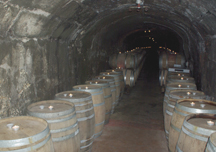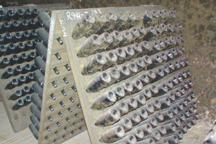California Wine Caves
by Terry Sullivan
From Wine Trail Traveler Newsletter, March 2007
What do you picture in your mind when you think of caves? Spelunking or perhaps crawling on all fours to fit through a small space? Perhaps the experience of absolute and complete darkness, the degree of darkness so dark you can’t see your hand in front of you? Maybe you imagine more sinister things such as spiders, cobwebs or other imaginable things in the dark. Caves evoke different ideas and feelings to many people. One idea is that of an ideal environment to age fine wine in oak barrels or age a sparkling wine in a bottle.
 Caves have been used for thousands of years for aging wines in different parts of the world. In our recent trip to Sonoma and Napa Valleys in California, we experienced different caves. Chinese workers built some caves in the late 1800’s after their work was completed on the railroads. These workers built miles of caves with the use of picks, axes and shovels. In contrast we also experienced caves built with modern technology such as a Welsh mining machine. The walls were then covered with shotcrete, a mixture of sandy cement and pea gravel.
Caves have been used for thousands of years for aging wines in different parts of the world. In our recent trip to Sonoma and Napa Valleys in California, we experienced different caves. Chinese workers built some caves in the late 1800’s after their work was completed on the railroads. These workers built miles of caves with the use of picks, axes and shovels. In contrast we also experienced caves built with modern technology such as a Welsh mining machine. The walls were then covered with shotcrete, a mixture of sandy cement and pea gravel.
Some of the caves were very clean and lit by electric fixtures whether they were overhead bulbs or elegant electric wall sconces. Other caves were darker and lit by candles or lanterns giving a romantic glow to the oak barrels lining the sidewalls. Other caves showed lichen growth hanging several feet from the ceiling. One wonders why they were never cleaned with a broom or vacuum. We observed thousands of bottles, showing dust resting quietly for years.
Early winemakers who came to the Napa and Sonoma regions from Europe were familiar with the use of caves. We trekked through two cave systems dating from the 1800’s.
One advantage of caves is temperature control. The cave temperature is often constant yearlong and varies very little. It doesn’t matter if the outside temperature is 110 degrees F or 10 degrees F, a cave system can maintain an even temperature often between 57 and 64 degrees F. This cool even temperature provides an ideal aging environment for wine. This constant temperature also provides economic benefits for a winery. Fewer resources are spent on heating or cooling a cave than a building. Often the land above a cave can be planted with grapevines.
 A second advantage of caves is darkness. Light can harm wines and caves are dark. This darkness is a particular advantage to sparkling wines undergoing aging in glass bottles.
A second advantage of caves is darkness. Light can harm wines and caves are dark. This darkness is a particular advantage to sparkling wines undergoing aging in glass bottles.
Humidity control is a third advantage of a cave system. Oak barrels breathe. Some of the wine evaporates. If the humidity is high, less wine will evaporate. In some cases caves have reduced the amount of evaporation from 6% to 1%. This also is an economic bonus for a winery since less wine is needed to top off the barrels.
Although the lichen hanging from the ceiling looked eerie at one winery we visited, it actually helps to filter the air in the cave.
 Some wine caves have an area that can be used for special events. The atmosphere can provide a rewarding experience. All of these advantageous led to an interest in constructing new caves during the 1980’s. Expect to see more wine caves constructed in the future.
Some wine caves have an area that can be used for special events. The atmosphere can provide a rewarding experience. All of these advantageous led to an interest in constructing new caves during the 1980’s. Expect to see more wine caves constructed in the future.
